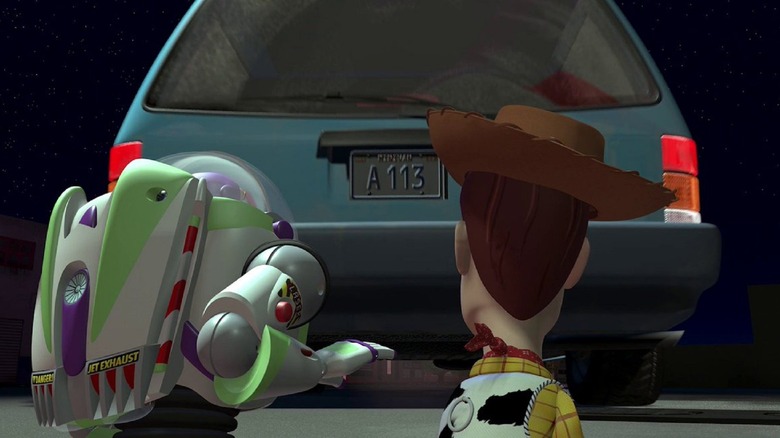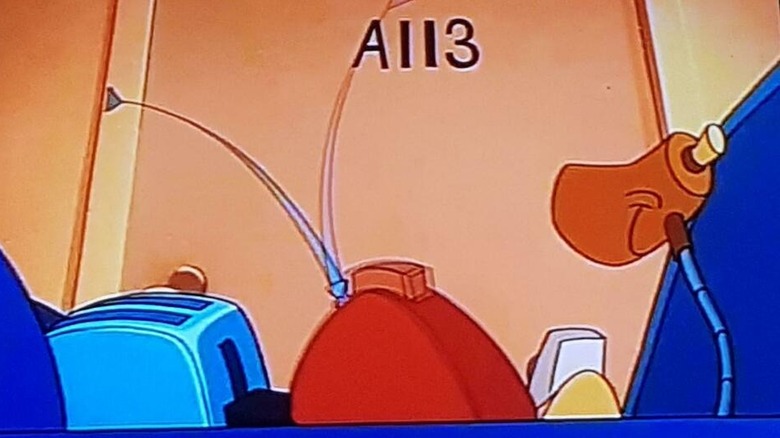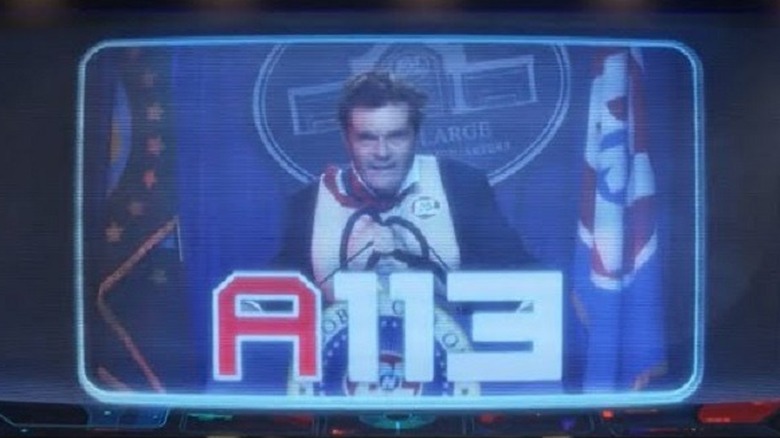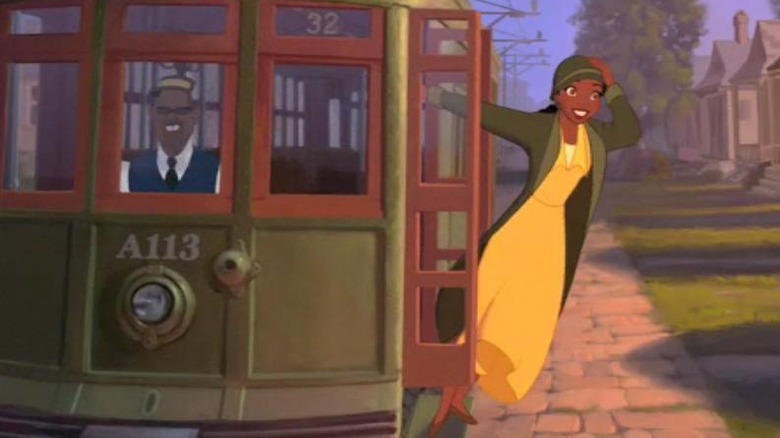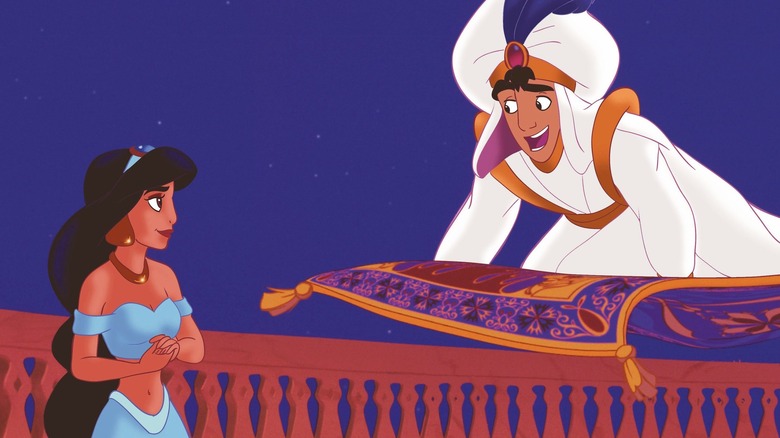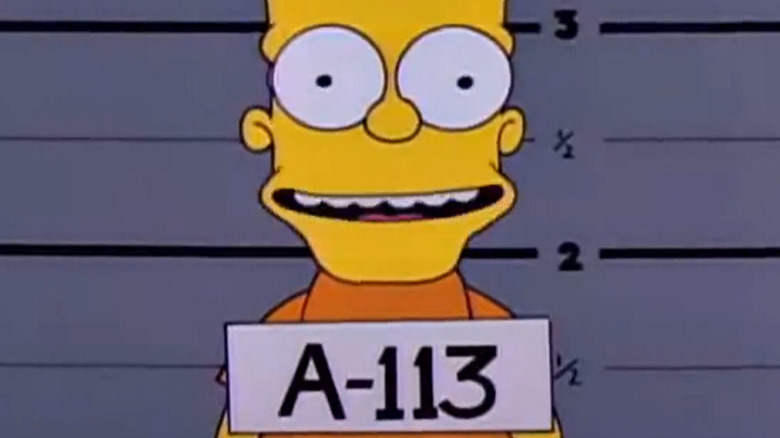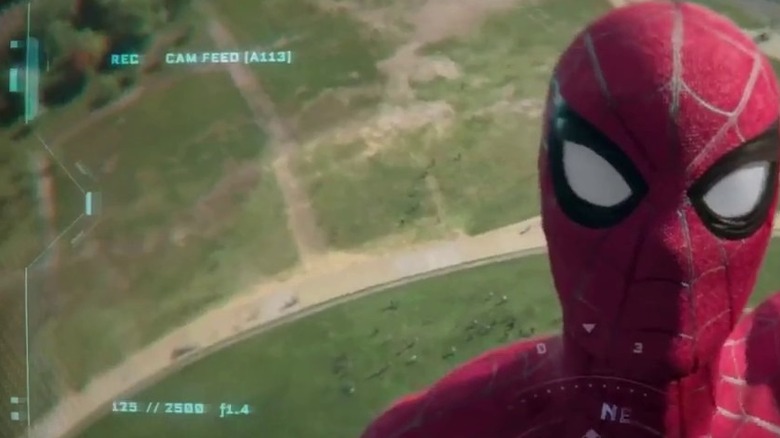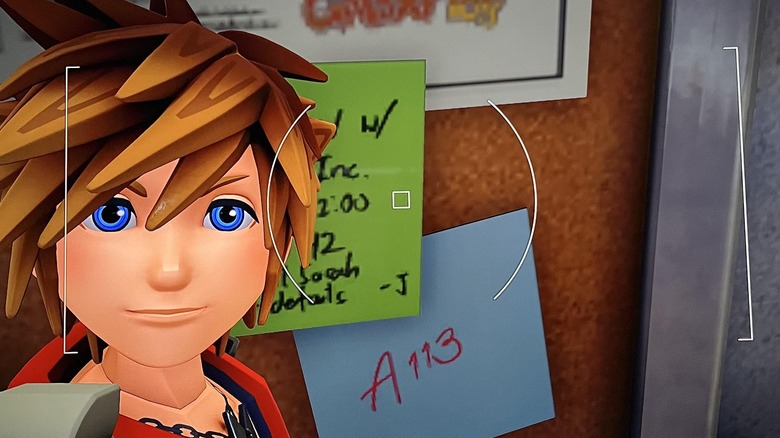The History Of Pixar's A113 Easter Egg Explained
Outside of officially connected cinematic universes like "Star Trek" or the Marvel Cinematic Universe, few studios are more famous for referencing past — and sometimes even future — films within other films than Pixar. From Pizza Planet to various elements of its early shorts, Pixar animators love to pack the periphery of their films with self-referential nods to their own work. Sometimes these Easter eggs are impossible to miss, while other times they go by so quickly that a carefully-timed pause is required to catch them. But Pixar has always made it worth fans' while to pore over every inch of every frame of the studio's films to find the many fun little secrets that the animators clearly have a blast sticking in.
While most of the Easter eggs in a Pixar movie are pretty easy to explain and define, there is one that is a bit more nebulous: the alphanumeric code "A113." From the time it was used as the license plate on Andy's mom's car in "Toy Story," the code has gone on to become an ongoing reference throughout Pixar's films through recent entries, including "Turning Red." Plenty of people have noticed it and know to look for it, but not everyone knows what it means or why it was ever used in the first place.
It's certainly not just some random grouping of numbers and a letter; A113 has a very specific origin that is deeply entrenched in the history of some of the most pivotal people at Pixar, not to mention its importance to Disney's overall history as well.
It's a classroom where animation is taught at CalArts
There are obviously a lot of talented folks at Pixar. And while we're not here to debate how much of a person's talent is naturally occurring and how much of it is learned, there's no denying that a certain classroom at a certain university had a hand in training some of the people who have helped to make Pixar what it is. As explained on Pixar's own YouTube channel, classroom A113 at California Institute of the Arts — or CalArts for short — is "where many Pixarians got their filmmaking start."
The school that became CalArts in 1961 was born from a merger of two financially-underperforming schools: the Chouinard Art Institute and the Los Angeles Music Conservatory. Walt Disney realized that many of his employees came from one of those two schools and joined together with other benefactors to set about combining the schools so that they could live on and continue to train future animators and filmmakers. His brother, Roy O. Disney, was also one of the founders of CalArts and helped ensure the school would continue on after Walt's death in 1966 — so that it could eventually see various future Pixar members pass through its halls.
Brad Bird is considered the first person to use A113 as an Easter egg
Among the Pixar favorites who studied in room A113 at CalArts was Brad Bird, whose biggest contribution to the studio is being the writer and director of both "Incredibles" movies — not to mention voicing sassy fashion designer Edna Mode. While the A113 references in Pixar movies predate Bird's work with the studio, A113 references predate those in Pixar movies. In fact, according to Daily Mail, Bird was the originator of A113 as an Easter egg in the first place.
The first example of A113 being referenced on screen is during an episode of the anthology series "Amazing Stories," which was created by Steven Spielberg and ran on NBC from 1985 to 1987. Bird co-wrote a Season 1 episode before returning in Season 2 with "Family Dog" — later spun off into its own short-lived series — which he wrote, directed, and voiced the titular canine. It was during that episode that A113 got its debut as an Easter egg when it was used as a license plate number, which remains one of its most common uses to this day.
A113 is also referenced literally every time Bird tweets — it's part of his Twitter handle.
It made its movie debut in The Brave Little Toaster
Between its journey from television to "Toy Story," A113 had already had its big screen debut elsewhere. The code appeared on a door in the 1987 animated film "The Brave Little Toaster," which might not be a Pixar movie but was worked on by several key figures who would soon play a major role in that studio. For starters, it was co-written by Joe Ranft, who has story and/or screenwriter credits on "Toy Story," "A Bug's Life," and "Cars." It was also the first CGI film ever pitched by a certain John Lasseter, director of the first three Pixar films and executive producer on many others (per The Wrap).
"The Brave Little Toaster" ended up being traditionally animated instead, with "Toy Story" eventually earning the distinction of the first fully computer-animated feature film. After Lasseter was fired following his CGI pitch for "Toaster," he ended up being one of the founders of Pixar, and the rest is history. In many ways, "The Brave Little Toaster" wound up paving the way for Pixar's future — not to mention the fact that "Toy Story" borrowed the concept of inanimate objects that come to life in the absence of humans from "Toaster." So the latter being the first movie to use A113 prior to it becoming a Pixar tradition makes a lot of sense in retrospect.
The director of The Brave Little Toaster was the first student accepted into CalArts' animation program
So if Brad Bird wasn't involved with "The Brave Little Toaster," why did A113 get referenced in it? Well, that's because the movie was directed and co-written by Jerry Rees, who was friends with Bird as well as John Lasseter at CalArts. He also has a particularly special tie to CalArts in terms of its notoriety for producing legendary animators — Rees was the very first student accepted into the school's new Character Animation Program in 1975 (per Vanity Fair).
Rees took what he learned in the program and applied it to character animation work for Disney movies like "Pete's Dragon" and "The Fox and the Hound." He then got to work on the trailblazing 1982 film "Tron," which laid some early groundwork for computer animation in film, bringing things full circle with his aforementioned CalArts pals and where their careers were headed. Bird first introduced A113 as a reference, while Rees took it to the movies — and neither of them could've possibly known just what an enduring Easter egg tradition they were starting.
A113 supposedly appears in some form or another in every single Pixar movie
While the use of A113 has become widespread throughout film and television — which we'll get more into in a bit — and didn't start with Pixar, the studio's use of it has become its most common appearance. So much so, in fact, that many people see it as a Pixar-specific thing. And that makes sense, given that it's become a game for fans to try and find how it's used in every Pixar movie.
Sometimes it's right in your face and is even a major plot point, such as in "Wall-E" (pictured above). Other times, it's used a little more creatively, like the way it appears in Roman numeral form in "Brave." Most often it's a background element like a license plate or apartment number, but there are also a few times when it is spoken out loud in some fashion by a character.
There may be one exception, however. Infamously, many fans claimed it doesn't seem to appear in "Monsters, Inc." which would make that the only Pixar movie thus far to seemingly not have an A113 reference. However, the sleuths of the internet found one possible inclusion, while outlets like the YouTube channel SuperCarlinBrothers claim that Pixar deliberately trolled its fans by filling "Monsters, Inc." with numerous almost examples of A113 just to tease viewers without ever fully committing to the reference. So A113 is either in every Pixar movie except for "Monsters, Inc.," or it's in "Monsters, Inc." in some extremely obtuse way.
It appears in non-Pixar Disney animated films as well
CalArts isn't a Pixar-specific institution, of course. In fact, as previously stated, combined with the other two schools that rolled into it, it has graduated a lot of Disney superstars. So it's not at all surprising that A113 has been used as an Easter egg in non-Pixar Disney animated movies as well. A couple of noteworthy examples include a license plate in "Lilo & Stitch," a trolley number in "The Princess and the Frog," and on a computer screen in "Big Hero 6."
That said, it has also spread to other non-Disney animated movies besides "The Brave Little Toaster." The underrated 1999 cult favorite "The Iron Giant" has a really cool-looking painting that contains A113 in the cluttered office of junkyard owner Dean. Sticking with the license plate theme, there is a car in the movie that has been damaged by the titular robot that has what is clearly meant to be an A113 license plate, though the 3 is missing. Of course, A113 showing up in "The Iron Giant" makes perfect sense — the movie was directed and co-written by Brad Bird.
Many key figures of the Disney Renaissance studied in room A113
After having struggled in the 1970s and much of the '80s, Disney badly needed things to turn around — otherwise, it might have been a company we'd be referring to in the past tense these days. Fortunately, in 1989, the company released "The Little Mermaid," which was a huge critical and commercial success that ended up kicking off the period known as the "Disney Renaissance."
The period, which is generally considered to have run through 1999, was marked with numerous films that would right the ship for Disney and lay the groundwork for it to become a company so successful that it would eventually be able to acquire Marvel, Lucasfilm, 20th Century Fox, and more. The CalArts website explains how a "core group of CalArts alums — including Glen Keane, John Musker, Gary Trousdale, Kirk Wise, Brenda Chapman, Chris Sanders, and Rob Minkoff — lead the way in reviving the animated feature film as an art form." One or more of those people worked on "Mermaid" as well as "Beauty and the Beast," "Aladdin," "The Lion King," and more.
In addition, a guy named Tim Burton also studied in A113 and helped to add another beloved Disney movie — "The Nightmare Before Christmas" — to that acclaimed era.
Famous non-animation CalArts alumni include Alison Brie, Paul Reubens, and many more
To be clear, CalArts isn't just a school for animators. The home page of its website states that it has "more than 70 comprehensive degree programs in the visual, performing, media and literary arts." As such, the institution has helped to put a lot of artists out into the world beyond just those who do their art in the form of animation. It's not total happenstance that Tim Burton teamed with composer Danny Elfman and actor Paul Reubens for his debut feature film "Pee-wee's Big Adventure"; he met them both at CalArts, even though Elfman just sat in on classes and was never an officially-enrolled student.
Looking at the CalArts School of Film/Video alumni page isn't just a who's who of animators both within and outside of the Disney family; you'll also find on that list James Mangold, director of multiple Oscar-winning films including "Girl, Interrupted," "Walk the Line," and "Ford v Ferrari." Among the graduates of the university's School of Theater are actors Alison Brie, Don Cheadle, Ed Harris, and Katey Sagal. And the School of Art alumni listing includes "Lost in Translation" director Sofia Coppola.
The Simpsons and other animated series have referenced A113
While Brad Bird has become best known for "The Incredibles" and his other film work, he was also a major creative force behind "The Simpsons" in its early years. Bird worked on the show for eight seasons, during which time his jobs included writer, director, storyboard artist, character designer, and executive consultant. Needless to say, this led to A113 being a frequently-occurring Easter egg on the Fox animated sitcom, starting during his stint on the show and continuing for many years after he left.
A113 has since become a go-to reference for many other animated series as well, including "Family Guy," "American Dad," and "BoJack Horseman." It has also penetrated live-action series like "Doctor Who" as well as some of Marvel's Disney+ shows. Some people like to poke fun at the reference as well, such as the A114 license plate of one of the main characters of the animated series "Big City Greens." As co-creator Chris Houghton told a fan who asked about it on his Tumblr page, "since [my brother] Shane and I didn't go to CalArts, it's our way of being lil stinkers."
Live action movies have referenced A113 as well
A113 isn't an Easter egg that is limited to animation on the big screen. Multiple films have referenced it in one way or another, particularly Disney movies. In "Saving Mr. Banks," for example, it is part of the flight number for P.L. Travers (Emma Thompson) as seen on the flight itinerary she is holding. In the 2020 adaptation of "Call of the Wild" starring Harrison Ford, a flyer near a map reads "Post A113." And it pops up multiple times throughout the Marvel movies, most commonly on a computer screen or digital display of some kind.
Back to Brad Bird, he of course has made sure to give the A113 plenty of life in his own live-action movies. In "Tomorrowland," the opening credits flat out call the film "An A113 Production," and he gives the number several shout-outs in "Mission: Impossible — Ghost Protocol." One seemingly random movie that contains an A113 reference is "The Hunger Games: Catching Fire," but that is until a little digging reveals that credited co-writer Michael deBruyn is actually a pen name sometimes used by screenwriter Michael Arndt (per TheScriptLab) — and Arndt has a Pixar connection in that he also wrote the Oscar-nominated screenplay for "Toy Story 3."
Films from CalArts animation program alumni have earned over $40 billion at the box office
In an article from FastCompany that humorously opens by taking a jab at people who doubt the value of creative arts degrees, the piece points to a graphic from CalArts that touts how much money the films of the school's graduates have earned at the box office. As it stands, that number has soared well past the $40 billion mark. The interactive graphic allows for looking at specific films, and reveals that the highest individual earners thus far are "Frozen," "Minions," "Finding Dory," Tim Burton's live-action "Alice in Wonderland," and "The Lion King."
As we've obviously focused heavily on Disney and Pixar throughout this feature, it seems only fair to show some love to some of the non-Disney movies besides "Minions" that have come from CalArts alumni that contributed a fair amount of cash to that $40 billion box office tally. Among some of the highest-earning of those are "The Secret Life of Pets," "Shrek 2," "Madagascar 3: Europe's Most Wanted," "Mission: Impossible — Ghost Protocol," "The Croods," and "Hotel Transylvania 2."
A113 has also shown up in video games
Television and film aren't the only places to find A113 as an Easter egg. It has also shown up in a few video games as well — most commonly, of course, in games that are directly adapted from a Disney film or are otherwise Disney-adjacent in some way. The video games "Kinect Rush: A Disney/Pixar Adventure" and "LEGO The Incredibles" both feature A113 as license plates and/or apartment numbers. Square Enix's "Kingdom Hearts III," one of the entries in the long-running RPG series that features characters traveling to various Disney worlds and meeting Disney characters, also has a car with an A113 license plate as well as a bulletin board with an A113 flyer.
As with film and TV, it isn't strictly Disney-related games that reference A113, either. For instance, the Microsoft Studios-published, Insomniac Games-developed 2014 open-world action game "Sunset Overdrive" isn't a Disney or Pixar game in any way but still contains its own A113 license plate on a vehicle. It's entirely possible that a member of the developer's staff attended CalArts, or it could just be a fun nod to the famous reference.
Either way, the possibility of A113 being hidden in video games opens up a whole new avenue for people to look for the reference and another medium for it to live on in for years to come.
